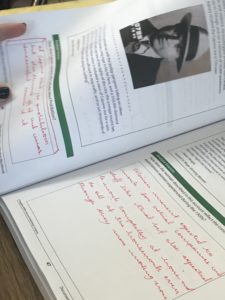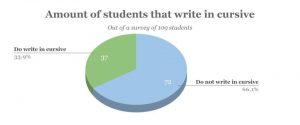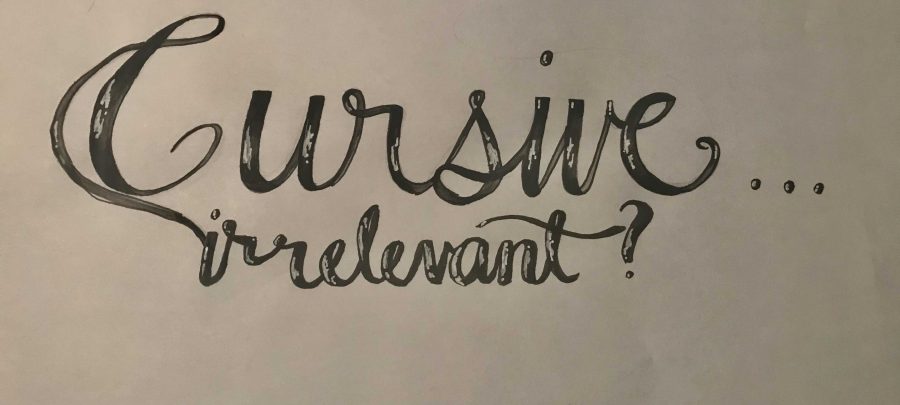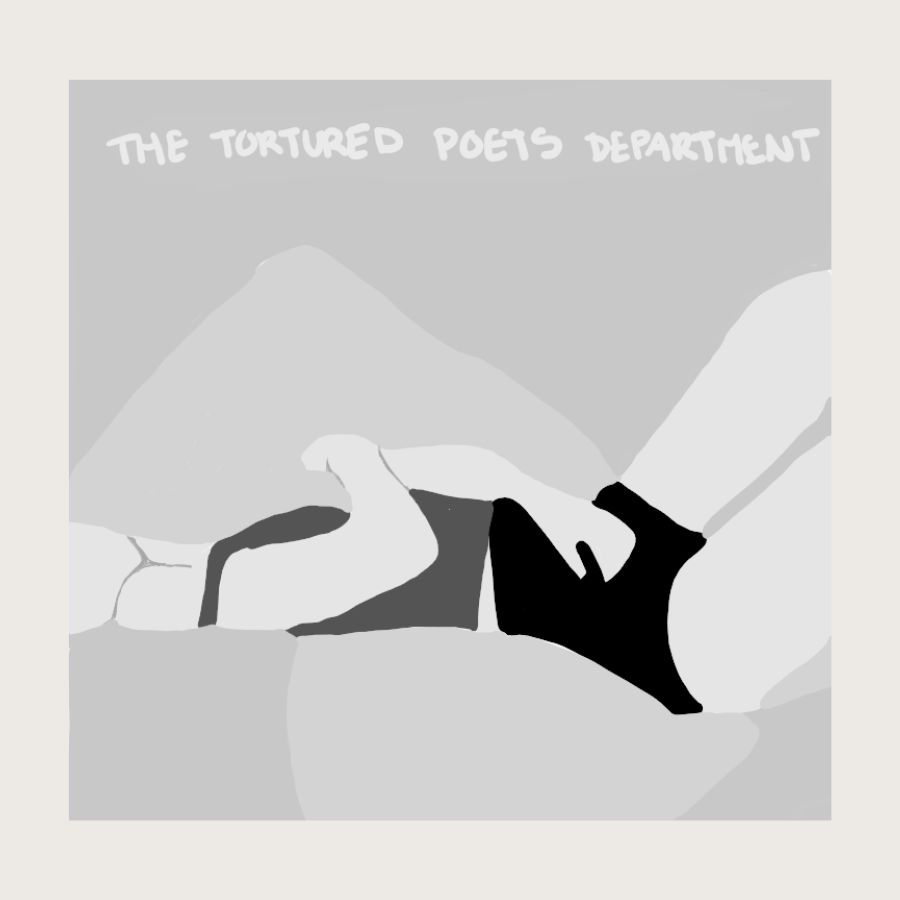Out with the old, in with the new

[dropcap size=small]S[/dropcap]ome teachers may have required cursive in the past, but it is quickly fading away from the handwriting of teen students. Cursive is simply not as important as it once was. A 2011 Cable News Network report noted that, “states don’t require children to learn cursive writing anymore. Some 46 states have adopted the Common Core Standards, a set of educational guidelines that do not require cursive writing as part of a school’s curriculum.”
Out of 109 Ventura High students, 72 admitted they don’t write in cursive often.
Senior Ava Gallo said her writing style is, “messy cursive mixed with print.” She added, “I think students should be taught cursive somewhat just because people still use it.”

Freshman Reece Pickett also stated, “I use printing when I’m handwriting normally because I find it a bit easier. I sign in cursive because it’s more formal.”
Junior Anna Grossi uses a combination of cursive in her handwriting because, “it’s easier for me to read and more fluid for me to write. As an amateur author and lover of reading, cursive will always hold more of an importance than typing and other modern ways of recording words.” Grossi explained why she feels this way, “Writing in cursive creates a visual representation of ancient and mysterious magic that typing can never amount to.”
Due to our frequent usage of electronics, much of our modern day communication is done on a keyboard, just one of the reasons cursive is becoming less relevant as time passes. Even if young students were still taught cursive, they’d have no use for it in today’s society. A better idea would be to teach typing, it’s a skill much needed for modern life.

AP English and ERWC teacher, Erin Jones, shared her thoughts on cursive relevancy, “I think it’s a nice skill to be able to read cursive and for writing speed, but we also type a lot and typing is probably more important than cursive.”
In response to the anti-cursive opinions out there, a counter argument may be that there are benefits of cursive that outweigh the evolving future that relies more on electronic methods of recording thoughts. Not only does cursive hold a sentimental spot for some, but it’s also attributed to stimulating the brain better than typing would. A study conducted by the College Board Scholastic Aptitude Test administered between March 2005 and January 2006 found that the 15 percent of the essays that were written in cursive received a slightly higher sub-score than printed essays.
Whether you think that cursive is relevant for what awaits us in the next decade or not, it is slowly becoming less significant as time passes.


















Noah C. Johnson • Nov 24, 2022 at 12:07 pm
the reality of this issue is that cursive is no more relevant than Latin (and much less interesting too), and it amounts to the inflection of severe pain on many people. I have had an actual root canal, and it hurt significantly less then writing cursive. just to provide a disclaimer on this, any perceived attack on cursive is meant to hurt mandatory cursive, not cursive per say.
CURSIVE SHOULD BE AN ELECTIVE ONLY. there are just not enough good reasons for it to be compulsory, but there more then enough for it to be offered, on the understanding and acceptance of the fact that many people will say no, but the interested will say yes. of course, I am a believer in the principle of a society that values freedom, so my default position on everything is that people are allowed to do something if they want to, but under no circumstance should they be mandated to do it; I require significant evidence to sway from that position, indeed if that is not how you are, there is no place for you in a society that values freedom. but anyway, Cursive has no role in modern life, and by the time anyone who is in school now is old enough to be employed, it will have even less of one
my arguments against cursive include:
I. cursive takes forever to master, and some never will no matter hard they try
II. cursive is impossible to write good enough (and I define something as being written ‘good enough’ when it has been written correctly point where the letters are recognizable, though written imperfectly), cursive has to be perfected before it can be written legibly even to those who can read it, bad cursive may as well be doodles, and many people will never get good at cursive
III. some cursive letters look so different from what people see in books, on the internet, or in handwritten print; that I think that Greek or Cyrillic (Russian) alphabet letters are more obviously some type of letter then cursive is; this is true of even well written cursive; poorly written cursive (I. E. what most people who learn cursive because of education mandates wind up with) is indistinguishable from scribbles
IV. to many people; myself included, even attempting cursive amounts to the gratuitous inflection of severe physical pain; I have experienced an actual root canal, and it hurt a lot less then trying to write cursive; I am 100% serious when I say that I would rather be waterboarded then write cursive. the possibility of inflicting serious physical pain would be not much of a problem if it was only done voluntarily, but when something is mandated in the education system, you have people who do not want to do it being forced to.
V. too many cursive letters look like each other, making them hard to distinguish; which is of course harmful to anyone trying to read anything. this is the case even when written “correctly”. what does it say of a writting style when the letter combinations “be” and “li” look almost identical and require several minutes of staring to make out. this is when they are written as they are supposed to be, when written improperly, they are even worse
VI. cursive only has advantages if your preferred writing instrument is a feather dipped in ink. I doubt the biggest cursive proponent has ever written with a feather and ink, and certainly does not do so regularly. not lifting the pen may be an advantage with feather and ink because those are hard to lift, can break easily, and can splatter ink all over; but no modern writing instrument has those properties. not lifting the pen slows you down because of the friction from the paper, and also having to go the same distances, and sometimes trace it. cursive became obsolete when the ballpoint pen was invented, that was in the late 1880s if you are wondering. you wanna talk about outdated?
VI. cursive makes it so that you get tiered so much quicker
VII. even most people who learn cursive abandon it the second it stops being required; which suggests there are a lot of better uses for everyone’s time
VIX. cursive makes dyslexia far far worse, in part because you can no longer make out the distinct letters. I think cursive set me back months in literacy.
X. cursive is slower, harder and less legible then print. print letter shapes are undeniably simpler, which makes them faster, easier and more legible, as well as requiring fewer strokes to write.
XI. handwriting is less necessary in the modern age in general, though to be honest I find this less compelling the above arguments, but why are we teaching 2 forms of something when it is debatable if we even need one? though I would say that if you want to save handwriting you should insist it become all print, but if you want to kill handwriting you should push cursive.
these are just some of the reasons cursive sucks. cursive proponents have no real arguments, but what passes for the most common ones can be refuted as follows:
1. the general benefits argument: its benefits are wholly unproven, no study has even proven benefits of cursive specifically, the closest is demonstrating that handwriting generally has some benefits, but no distinction between cursive and print; I have read dozens of studies about the issue, and none back up cursive when you read what they actually say. most people who claim “brain benefits” will not articulate what they even think those benefits are, and usually will not dive into the question of if any verifiable facts support those benefits. every study cursive proponents quote turns out to be either misquoted, taken out of context, overtly lied about, or cites a source that engages in this behavior. often they do not cite the anything at all. rarely do they articulate what benefits they think cursive has. *Ipse dixit statements just don’t work for convincing me of the benefits of something.
2. the speed argument: this one is based on a flat out distortion of fact if not full blown lies, and it doesn’t pass the smell test of truth either; I have found even illegible cursive to be incredibly slow, much more so then print. you want me to believe that adding a bunch of elaborate, frilly, pretentious, ornate, intricate, and gratuitous loops, curls, tails, flourishes, swirls and curlicues to letterforms speeds up writing? how could anyone have so little common sense so as to think that? this one is exceptionally stupid, but to be sure, I checked the research, and there are studies that show that cursive can, for some people, but not others, be faster only if legibility is not a concern at all, but those same studies find that legible cursive is significantly slower then legible print, which shouldn’t be a surprise given all those ornate loops and curls cursive letterforms have; cursive is much slower compared to print of equal legibility. also I happen to find illegible cursive to be significantly slower then legible print, or even illegible print. did I mention that cursive cannot be written “close enough” (or good enough that you can read the letterforms though they are imperfect), whereas print can, cursive has to be perfected before it can be used
3. the historical documents argument: this one is especially ridiculous when you think about it, and let me explain why:
A. it is possible to know how to read something without being able to write it yourself (for example I can read blackletter and Gaelic Script [which is not even typically used for writing English, though it can be used for that, outside of rare decorative inscriptions in Ireland, and a single house decoration my grandma owned; it never is, and never was; Irish Gaelic, by some accounts an endangered language is what is typically written in Gaelic script], but I will never be able to write either of them myself, in both cases my ability to read them is in fact better than I can read cursive; which I was years ago forced to waste excessive amounts of time learning to write, but no one ever bothered teaching us how to read); indeed many courses in dead languages like Latin focus on being able to understand what is already written in the language, not on being able to speak it or write it yourself
B. there are thousands of places you can find print versions of America’s founding documents, both hard copy and digital; some of the hard copies are from that era, those versions actually being what most people read, not the “originals”; and changing the font in which words are written does not change the meaning of them; if anyone asks I can show you some of those locations
C. the cursive versions of those documents are not in ‘modern’ (palmer style) cursive; but instead an older form known as “copperplate”, which is very different; also, the spelling is not the same as is typical today (for instance the constitution contains the words “chuse”, “Pensylvania”, “controul” and “defence” [that is how the document actually spells them]; among others); and they documents use the long s (an archaic form of a letter that cursive classes never mention even exists); add to that the fact that I have seen the originals of them for myself, and the writing is faded to the point of being barely legible; I could also add that the original version of the constitution capitalizes the first letters of common nouns, something that has vanished from English today, but should seem familiar if you have learned German as a foreign language like I have, but I think the point is clear even without that
D. reading the originals requires a trip to a specific room in Washington DC, which only a few people are able to do. and also, even if you can read cursive, you cannot read them in whole, as the displays they are on are permanently exposed to the first page only; so good luck with your impression of Nicholas Cage in the movie “National Treasure”; as that is the only way you will have the chance to read more than the 1st page of the originals; which you will be able to enjoy your new knowledge of them from prison, as stealing the original copies of the constitution or the declaration of independence is one of the most serious forms of theft from the US government possible, so expect to be on the FBI wanted list, for life, even if you somehow avoid jail; anyone dedicated enough to do all that will have certainly studied reading cursive enough to read it even if cursive is not taught in schools
E. even if this is a skill that is taught, it is so niche that it should be AN ELECTIVE ONLY, some will choose to take it, some will not; if there are still historians, archeologists, and linguistics scholars who can read Hieroglyphics, Ancient Greek, Latin, Old English, Sanskrit, and Cuneiform, we can be sure a few will take that class
in short, cursive is both not needed, and not enough to read those documents in the original; and should be consigned to an elective like Latin. there is a distinction between skills vital enough that everyone should have them, and those that a few specialists need (and can learn without forcing the rest of us to spend hours learning it)
4. the what if digital devices are unavailable/ fail argument: if that happens, we can use print handwriting, which is easier to read, easier to write, faster to write period in my opinion, and undeniably faster to write legibly, looks like what we see in books and on those digital devices; and which no one is seriously proposing getting rid of; many proponents of cursive seem to be conflating handwriting with cursive, when cursive is a single exceptionally difficult and pompous looking variety of handwriting; don’t confuse a single exceptionally ornate and outdated form of a concept with the whole of the concept. indeed if we just need handwriting and any handwriting will do, in the absence of a particular reason otherwise, it makes sense to use the easiest form of handwriting
5. the dyslexia argument: this one is simply false, I am mildly dyslexic myself, and cursive didn’t help me at all with spelling or writing, and in some ways made it worse. Cursive has more letters that look like each other then print does.
6. the signature argument: legally signatures do not have to be in cursive; they don’t even have to resemble your name. signatures can be printed, x marks, black letter, letters of the Russian alphabet, Chinese characters, a stick figure drawing of a cartoon character, a form of cursive other then palmer method (such as copperplate, Spenserian or Getty-Dubay) random squiggles, or something else; all that matters is that it is distinctive. most cursive signatures degenerate into squiggles anyway.
7. the letters from grandma argument: honestly, I find it unrealistic in several ways; for one I have never seen my grandparents write in cursive, ever. also, someone else can transliterate them. as mentioned previously, learning to read something does not absolutely require being able to write it yourself. also, I think grandma has a problem if she is sending people letters in a form of handwriting they cannot read, surely the burden should be on the person sending the letters to make them legible to the recipient. If they are addressed to someone else, then maybe its not our business to read them
8. the beauty argument is ridiculous for several reasons. For one, there is much better out there, if you want beautiful looking letters, try Bengali as a foreign language. The letters of Bengali (especially, but not limited to “kô” the first letter in their equivalent of alphabetical order) blow even the best looking written English out of the water. if you have seen what Bengali looks like, you can’t possibly tell me that ‘b’s that look like ‘l’s, ‘n’s that sometimes look like ‘m’s, ‘q’s that look like 2s or z’s that look like a cut open human heart (or at least that is the closest describable thing they look like to me), or similar forms are better looking than Bengali kô, and you don’t have to be able to read or speak Bengali to think those letters are good looking. I included links to a galleries of bengali letters at the end of this comment in case you have never seen them (the first one is kô, the second is a gallery of the base consonants, the third is a gallery of the vowels in independent form [I. E. the way they are written when they occur at the start of a word], the fourth is what “kô” looks like with the markers to indicate vowel sounds besides ô attached, the fifth is a gallery of the conjunct consonants which are much more complex). if we want everyone’s writing to look pretty, we should learn Bengali, not cursive; but off that tangent. Two, most people’s cursive is truly ugly and awful, only a few people can write cursive in an aesthetically pleasing manner. Three, beauty is a subjective opinion, and mandates that apply to all should not be based on subjective opinions unique to some; I find the form of cursive taught in schools to be very ugly with the sole exception of the letters s and c (the former only when lowercase). Four, there is pretty looking print as well, for instance try Gaelic Type, I find it much prettier and more legible then cursive. Five, aesthetic concerns are not a good reason to mandate that all people put a lot of hard work into something. It would be different if only people who voluntarily chose too put the work in though, but cursive as an elective would meet that criteria, mandatory cursive does not.
9. the “creativity” argument: this one is absurd; you want me to believe a highly regimented and standardized process that is extremely difficult improves creativity? creativity is doing things in you own way, not conforming to a standardized model.
10. the “individuality” argument: this is the last argument, just phrased in an even more absurd manner. Individuality comes from doing things your own way, as you see fit, without regard to how others do them. A highly regimented and standardized modal that everyone has to conform to (and make no mistake, that is how cursive is taught), is the opposite of that. To argue otherwise is to define the meaning out of the English language and say “up is down”, “large is small”, “black is white”, “life is death”, and “hot is cold”. Individuality can also never be forced, forcing someone to be an individual with mandates is a logical contradiction in terms. Mandates and requirements can only destroy individuality, never create it.
11. the “not hard argument”: this one is flat out false, at least for some of us; cursive in fact often takes a long time, some people may get it immediately, but others make take over a year of tedious practice for several hours a day, and still never get the hang of it. Cursive is in fact very hard, and takes forever to master. Print letter shapes are simpler, more constantly reinforced by seeing them in books, etc; and can be written “close enough”. Additionally even 15 minutes a day every weekday adds up to a lot of time, over the course of a month it already amounts to 5 hours.
12. the “knowledge” argument: this one could be used to justify a lot of things it is not used for. The language of Irish Gaelic is “knowledge”, should we mandate everyone in America learn that? Not bad mouthing Gaelic, I am doing a self-paced online course for learning it right now, and enjoying it; but that does not mean I think all the schools in America should require everyone to learn it. Reading hieroglyphs is also “knowledge”. So is knowing how to use an abacus, or shoe a horse. This has other applications, for instance it is in fact knowledge to know how to burp exceptionally loudly. All the above forms of knowledge should be available for those who want them to obtain, but we should not spend 5 minutes a century requiring every single person to master them, which is what cursive in the elementary school classroom does. In fact there are so many forms of knowledge that if we required everyone to learn absolutely everything, no one would ever graduate, and the schools would last several times the human life span at least, and there would be no freedom anywhere. You don’t want that do you? When it comes to the knowledge we require everyone to have, we must be choosy. In my view only the essential stuff should be mandatory, the burden must be on proponents of something to prove why it is essential. Cursive supporters have not done that.
13. the “abstraction and exposure” argument: the purported benefit, while I have no clue if it is even true (I really don’t) can also be done with any other writing system too. the best way to get that advantage, based on the general logic underlying your idea, is probably to try learning a language with a different writing system. something like Russian, Greek or Hindi or Bengali or Hebrew as just a couple examples. learning to read those languages introduces a much greater degree of abstraction then cursive as there is not even a one-to-one letter correspondence with English, and you can actually use them to communicate with people from other countries, unlike cursive. it will also be easier to retain the knowledge by reading things in the script, as you can actually find written material in languages that use different scripts, unlike in cursive (seriously, there are zero books in cursive as far as I know, it is easier to find books in Latin, a foreign dead language that has not had any native speakers in over 1000 years then it is to find them in cursive.) I have read that Russian and Greek are in particular good first steps for someone who wants to be able to ready anything besides the roman script, because they are still alphabets just with different letters and sounds. but if you wanted to really abstract things and encourage “thinking differently”, maybe using a language written with an abjad, an abugida, a syllabary, or logograms would take it even further. that is in addition to the good look of Bengali as I mentioned above. anyway, those options would also have that advantage, and several additional ones.
if you have any that are not subsets of those, tell me so I can knock it down.
I will concede that cursive does have the “advantage” of looking more pompous.
on the other hand, the case against cursive included among other things, the freedom argument (that the default position is you are not required to, but can if you want to), but also the fact that we cannot teach everything to everyone, so the things we mandate everyone learn should be limited to things with clear benefits. additionally, there are hundred of more relevant things that time could be used for. also, for many people (including myself, but others to an even greater degree) cursive is awful, they just cannot write it, and even trying causes significant pain. to people who struggle with long handwriting anyway, cursive is pure torture. It is an open question whether I would rather be water boarded or write cursive, I would have to think hard. and I know of people who have worse experiences with cursive then I did! I would prioritize peoples freedom from serious physical pain over what nostalgic luddites who don’t know what century they live in think looks good, at least when it comes to what people are required to do, even if you think it looks nice, it is grossly selfish not to in that situation. I am not necessarily calling for an end to cursive, I am calling for an end to compulsory cursive.
there are things that are and should be desire dependent, those who want them should have them, but no other people should. to disagree with that is to accept the principle underlying totalitarianism. all the actual facts in the modern era place cursive in that category. Cursive should be TAUGHT AS AN ELECTIVE ONLY. it is no more essential then Latin, and in my subjective opinion, less interesting. I am very confident that a substantial minority would take the elective. the people who are specifically interested, and no one else, should learn cursive. LET CURSIVE SURVIVE AS AN ELECTIVE!!!!!
it is a great thing that many schools are getting rid of cursive; and any backlash is pure nostalgia, not rational argument. being able to speak a dead language has more use then cursive, so why mandate cursive? for that reason, cursive is in fact pointless.
*Ipse dixit is a phrase that refers to something that is asserted without any proof, or reason the thing is the case, or explanation of how the thing is the case. a statement of that type is dogmatically asserted and then one tries to opt out of logical argument all together. the term from a Latin phrase that translates as “he said it himself”, Cicero used the phrase to describe things simply dogmatically asserted; which is generally what cursive proponents are doing about why it should be taught. please note that most of these individual paragraphs contain far more detailed reasons as to why my opinion is the case then cursive mandate proponents have offered